Abstract
Ambulatory pulmonary artery pressure monitoring by means of a transducer tipped catheter with a simultaneous frequency modulated electrocardiogram and a miniaturised tape recorder was used to study the haemodynamic implications of ST segment depression in patients with coronary artery disease. Nineteen male patients (mean (SD) age 58 (11) years) with clinical and angiographic evidence of coronary artery disease were studied together with six controls. Changes in the ST segment and pulmonary artery diastolic pressure during treadmill exercise, atrial pacing, and unrestricted ambulant activity were analysed. During exercise, pulmonary artery diastolic pressure rose significantly in patients with coronary artery disease but not in the controls. One patient with ST depression greater than 1 mm did not have a rise in pulmonary artery diastolic pressure on exercise; two had a rise in pulmonary artery diastolic pressure with no ST segment change despite severe angina. The pulmonary artery diastolic pressure tended to rise before or simultaneously with the onset of ST segment depression. The haemodynamic response to atrial pacing was similar in normal controls and patients with coronary artery disease. During ambulatory monitoring there were 29 episodes of ST segment depression all of which were associated with a rise in pulmonary artery diastolic pressure and chest pain. The onset of ST segment depression occurred before a rise in pulmonary artery diastolic pressure in 11 episodes, was simultaneous with it in 11, and followed it in seven episodes. During exercise and ambulatory monitoring there was a correlation between the magnitude of ST segment depression and the rise in pulmonary artery diastolic pressure. Pain was a late feature during exercise, atrial pacing, and anginal episodes. This technique for the first time allows the relation between ST segment changes and haemodynamic alterations in left ventricular function to be assessed in ambulant patients with coronary artery disease.
Full text
PDF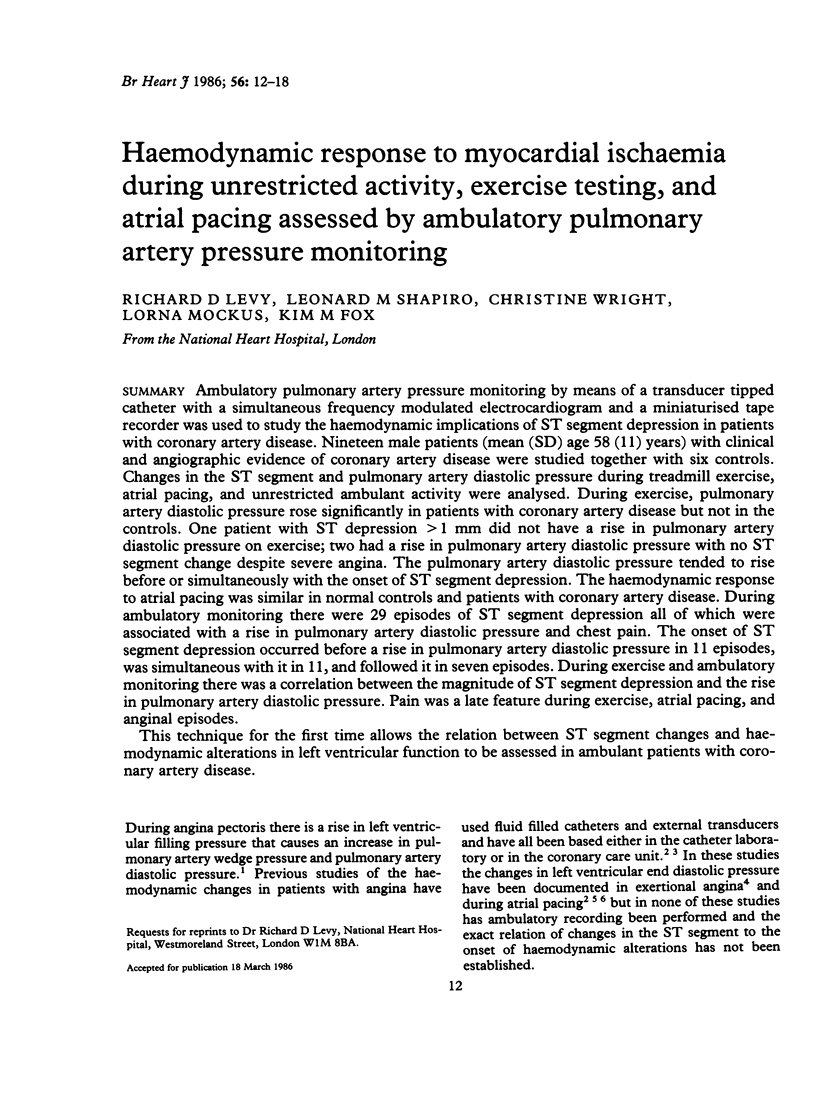
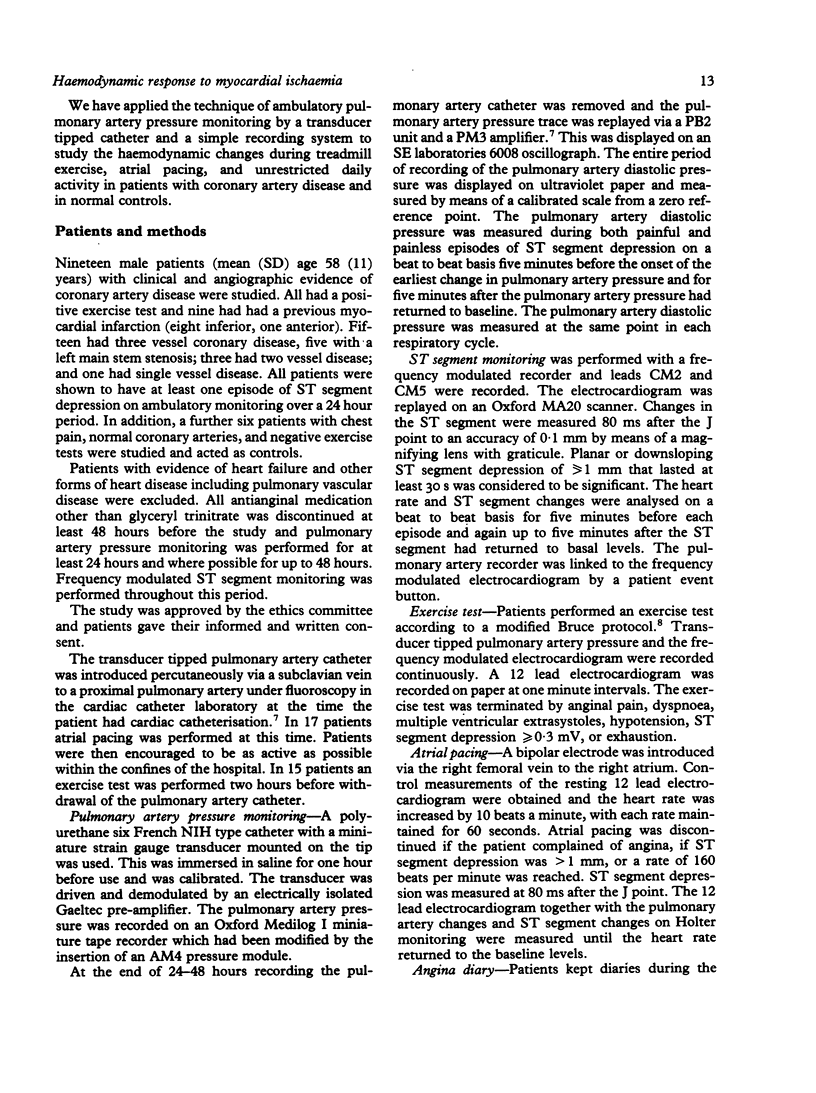
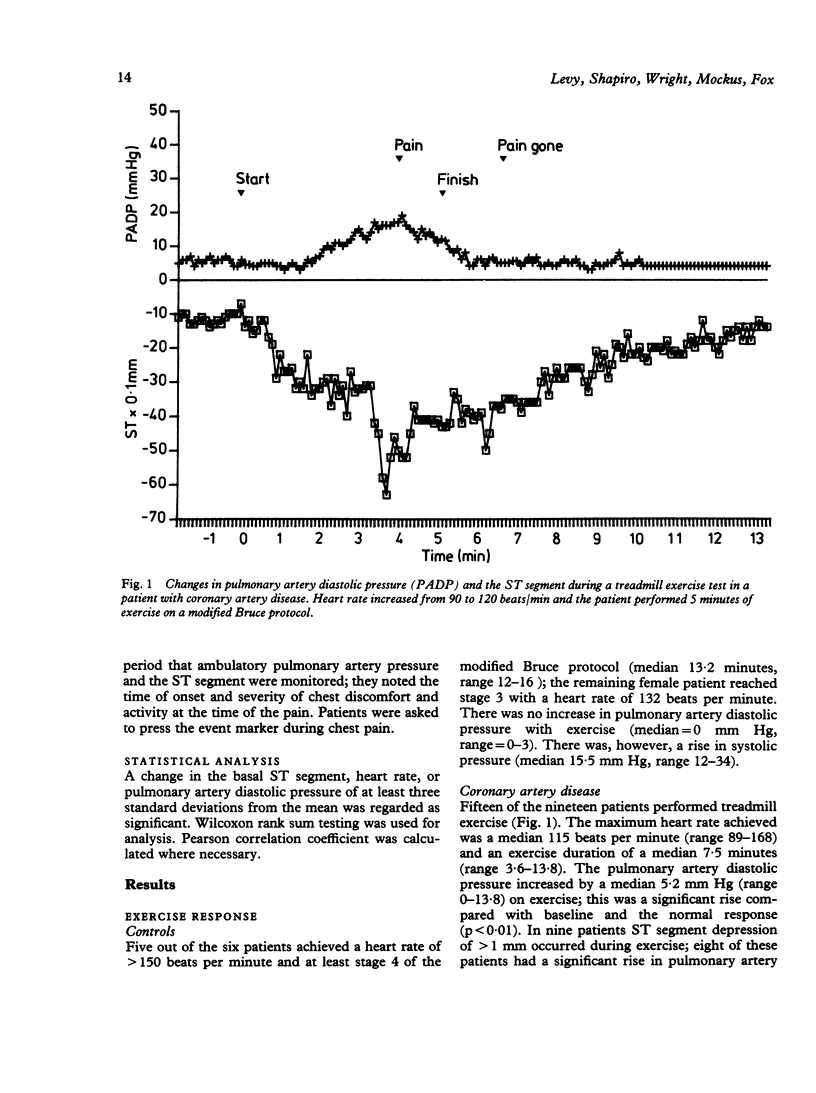
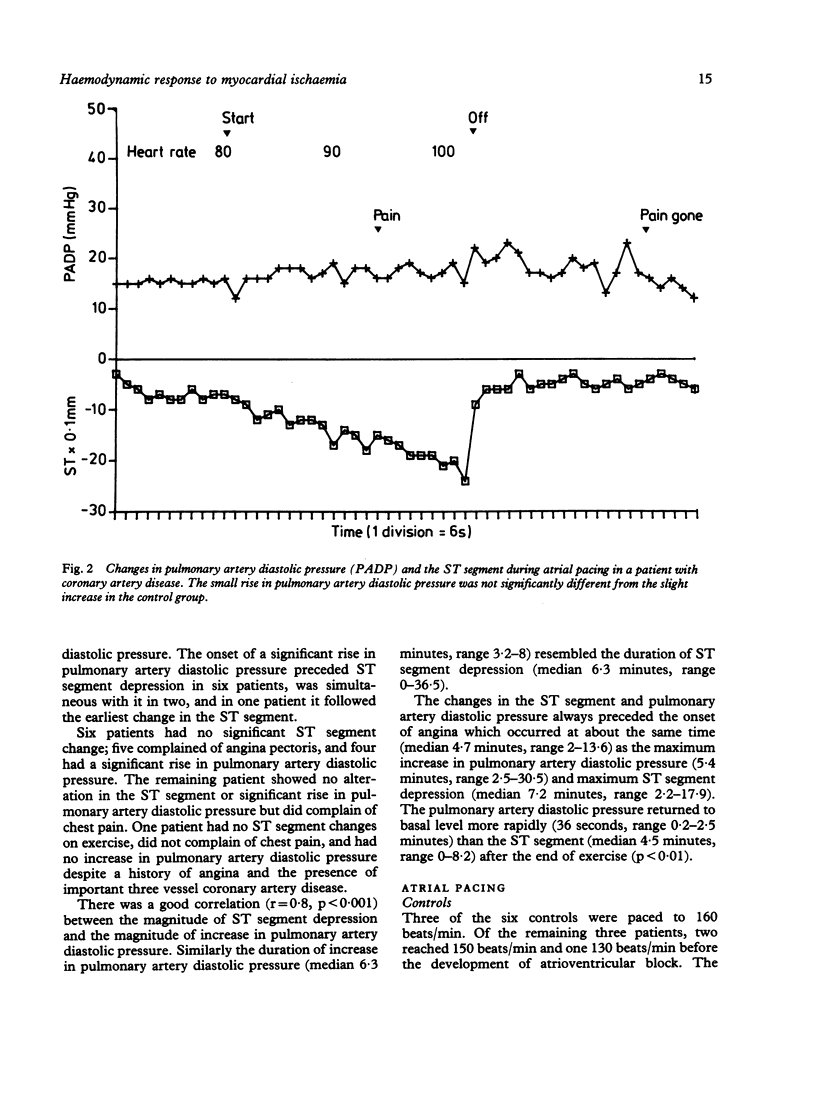
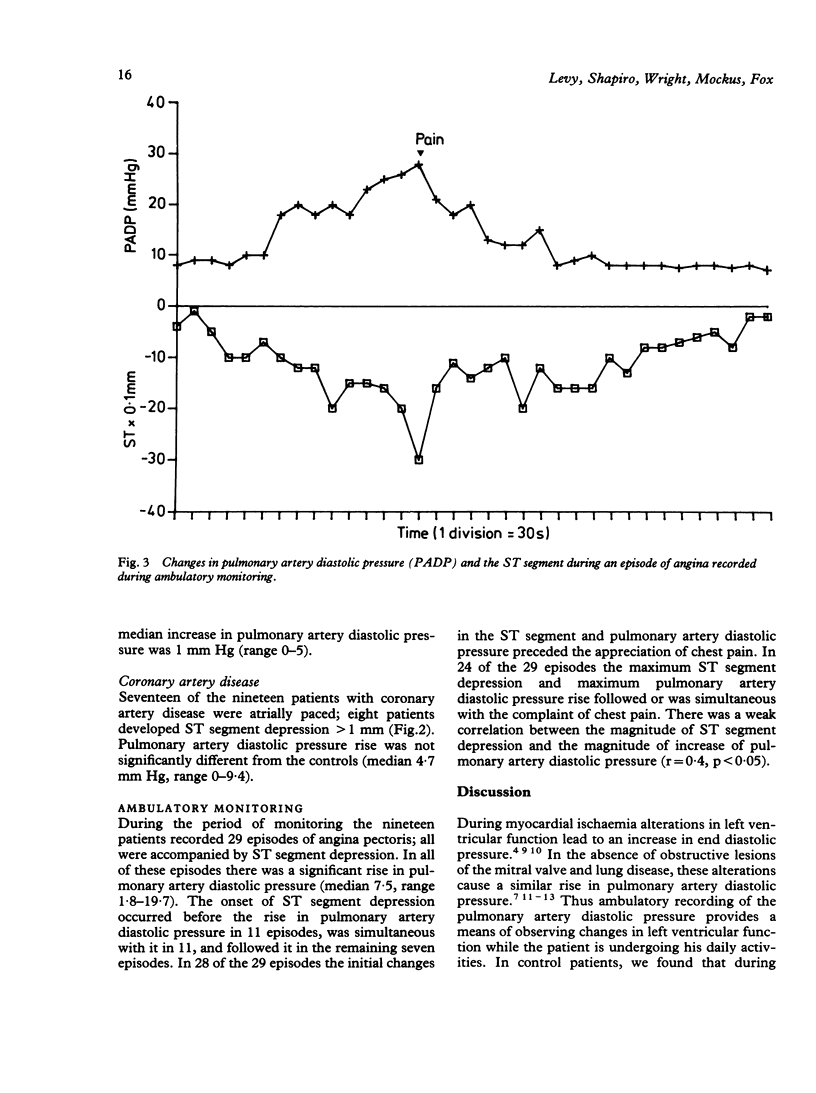
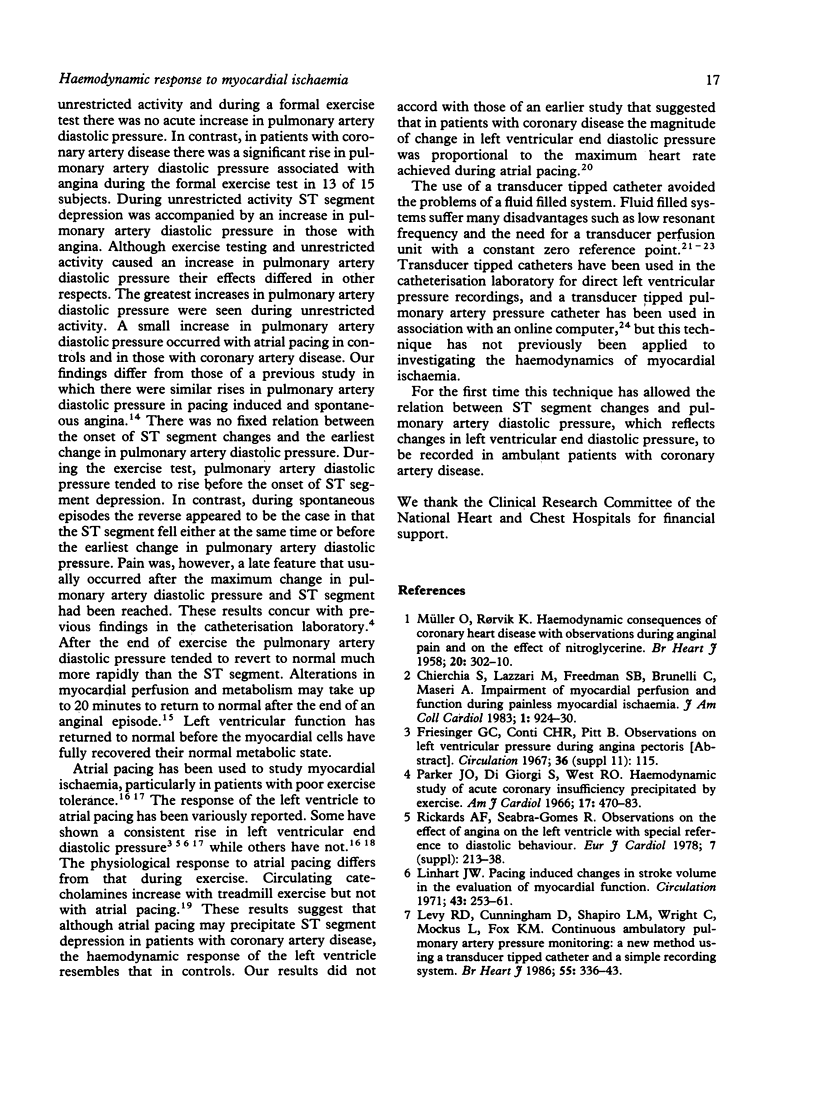
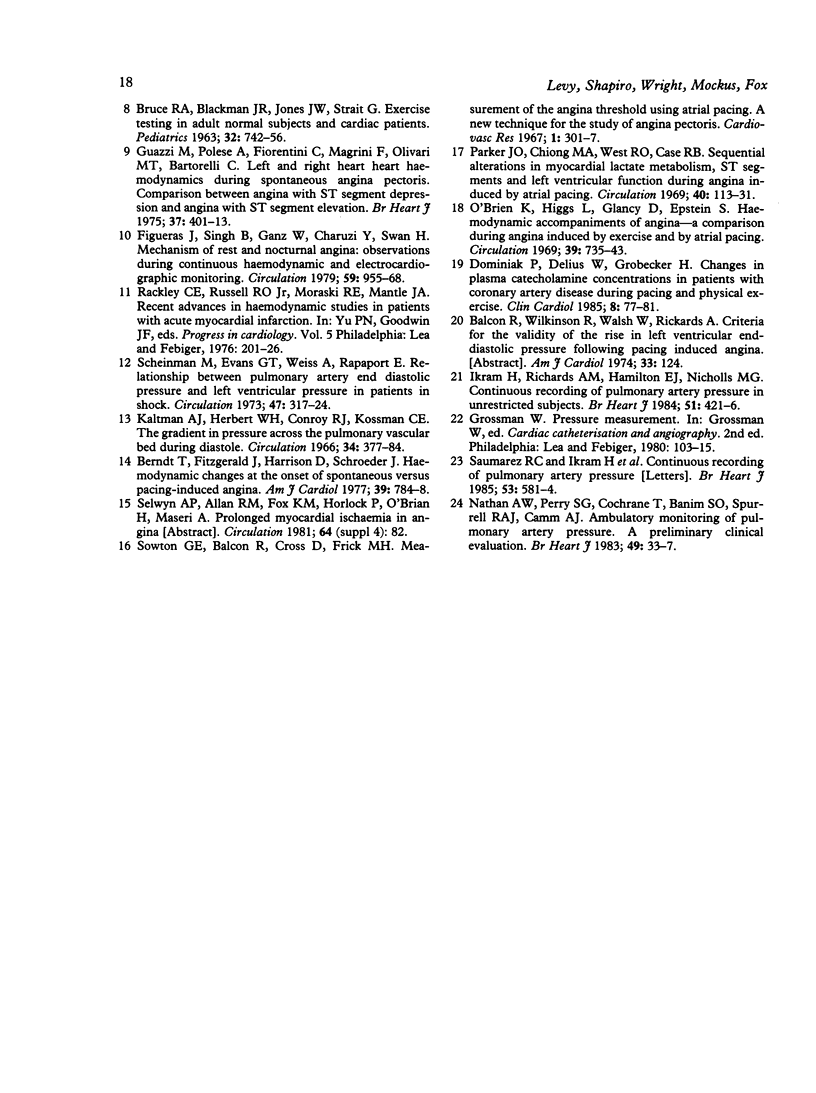
Selected References
These references are in PubMed. This may not be the complete list of references from this article.
- BRUCE R. A., BLACKMON J. R., JONES J. W., STRAIT G. EXERCISING TESTING IN ADULT NORMAL SUBJECTS AND CARDIAC PATIENTS. Pediatrics. 1963 Oct;32:SUPPL–756. [PubMed] [Google Scholar]
- Berndt T. B., Fitzgerald J., Harrison D. C., Schroeder J. S. Hemodynamic changes at the onset of spontaneous versus pacing-induced angina. Am J Cardiol. 1977 May 26;39(6):784–788. doi: 10.1016/s0002-9149(77)80027-1. [DOI] [PubMed] [Google Scholar]
- Chierchia S., Lazzari M., Freedman B., Brunelli C., Maseri A. Impairment of myocardial perfusion and function during painless myocardial ischemia. J Am Coll Cardiol. 1983 Mar;1(3):924–930. doi: 10.1016/s0735-1097(83)80211-3. [DOI] [PubMed] [Google Scholar]
- Dominiak P., Delius W., Grobecker H. Changes in plasma catecholamine concentrations in patients with coronary heart disease during pacing and physical exercise. Clin Cardiol. 1985 Feb;8(2):77–81. doi: 10.1002/clc.4960080204. [DOI] [PubMed] [Google Scholar]
- Figueras J., Singh B. N., Ganz W., Charuzi Y., Swan H. J. Mechanism of rest and nocturnal angina: observations during continuous hemodynamic and electrocardiographic monitoring. Circulation. 1979 May;59(5):955–968. doi: 10.1161/01.cir.59.5.955. [DOI] [PubMed] [Google Scholar]
- Guazzi M., Polese A., Fiorentini C., Magrini F., Olivari M. T., Bartorelli C. Left and right heart haemodynamics during spontaneous angina pectoris. Comparison between angina with ST segment depression and angina with ST segment elevation. Br Heart J. 1975 Apr;37(4):401–413. doi: 10.1136/hrt.37.4.401. [DOI] [PMC free article] [PubMed] [Google Scholar]
- Ikram H., Richards A. M., Hamilton E. J., Nicholls M. G. Continuous recording of pulmonary artery pressure in unrestricted subjects. Br Heart J. 1984 Apr;51(4):421–426. doi: 10.1136/hrt.51.4.421. [DOI] [PMC free article] [PubMed] [Google Scholar]
- Kaltman A. J., Herbert W. H., Conroy R. J., Kossmann C. E. The gradient in pressure across the pulmonary vascular bed during diastole. Circulation. 1966 Sep;34(3):377–384. doi: 10.1161/01.cir.34.3.377. [DOI] [PubMed] [Google Scholar]
- Levy R. D., Cunningham D., Shapiro L. M., Wright C., Mockus L., Fox K. M. Continuous ambulatory pulmonary artery pressure monitoring. A new method using a transducer tipped catheter and a simple recording system. Br Heart J. 1986 Apr;55(4):336–343. doi: 10.1136/hrt.55.4.336. [DOI] [PMC free article] [PubMed] [Google Scholar]
- Linhart J. W. Pacing-induced changes in stroke volume in the evaluation of myocardial function. Circulation. 1971 Feb;43(2):253–261. doi: 10.1161/01.cir.43.2.253. [DOI] [PubMed] [Google Scholar]
- MULLER O., RORVIK K. Haemodynamic consequences of coronary heart disease with observations during anginal pain and on the effect of nitroglycerine. Br Heart J. 1958 Jul;20(3):302–310. doi: 10.1136/hrt.20.3.302. [DOI] [PMC free article] [PubMed] [Google Scholar]
- Nathan A. W., Perry S. G., Cochrane T., Banim S. O., Spurrell R. A., Camm A. J. Ambulatory monitoring of pulmonary artery pressure. A preliminary clinical evaluation. Br Heart J. 1983 Jan;49(1):33–37. doi: 10.1136/hrt.49.1.33. [DOI] [PMC free article] [PubMed] [Google Scholar]
- O'Brien K. P., Higgs L. M., Glancy D. L., Epstein S. E. Hemodynamic accompaniments of angina: a comparison during angina induced by exercise and by atrial pacing. Circulation. 1969 Jun;39(6):735–743. doi: 10.1161/01.cir.39.6.735. [DOI] [PubMed] [Google Scholar]
- Parker J. O., Chiong M. A., West R. O., Case R. B. Sequential alterations in myocardial lactate metaboli, S-T segments, and left ventricular function during angina induced by atrial pacing. Circulation. 1969 Jul;40(1):113–131. doi: 10.1161/01.cir.40.1.113. [DOI] [PubMed] [Google Scholar]
- Parker J. O., Di Giorgi S., West R. O. A hemodynamic study of acute coronary insufficiency precipitated by exercise. With observations on the effects of nitroglycerin. Am J Cardiol. 1966 Apr;17(4):470–483. doi: 10.1016/0002-9149(66)90237-2. [DOI] [PubMed] [Google Scholar]
- Rickards A. F., Seabra-Gomes R. Observations on the effect of angina on the left ventricle, with special reference to diastolic behavior. Eur J Cardiol. 1978 Jun;7 (Suppl):213–238. [PubMed] [Google Scholar]
- Saumarez R. C. Continuous recording of pulmonary artery pressure. Br Heart J. 1985 May;53(5):581–584. doi: 10.1136/hrt.53.5.581. [DOI] [PMC free article] [PubMed] [Google Scholar]
- Scheinman M., Evans G. T., Weiss A., Rapaport E. Relationship between pulmonary artery end-diastolic pressure and left ventricular filling pressure in patients in shock. Circulation. 1973 Feb;47(2):317–324. doi: 10.1161/01.cir.47.2.317. [DOI] [PubMed] [Google Scholar]
- Sowton G. E., Balcon R., Cross D., Frick M. H. Measurement of the angina threshold using atrial pacing. A new technique for the study of angina pectoris. Cardiovasc Res. 1967 Oct;1(4):301–307. doi: 10.1093/cvr/1.4.301. [DOI] [PubMed] [Google Scholar]


